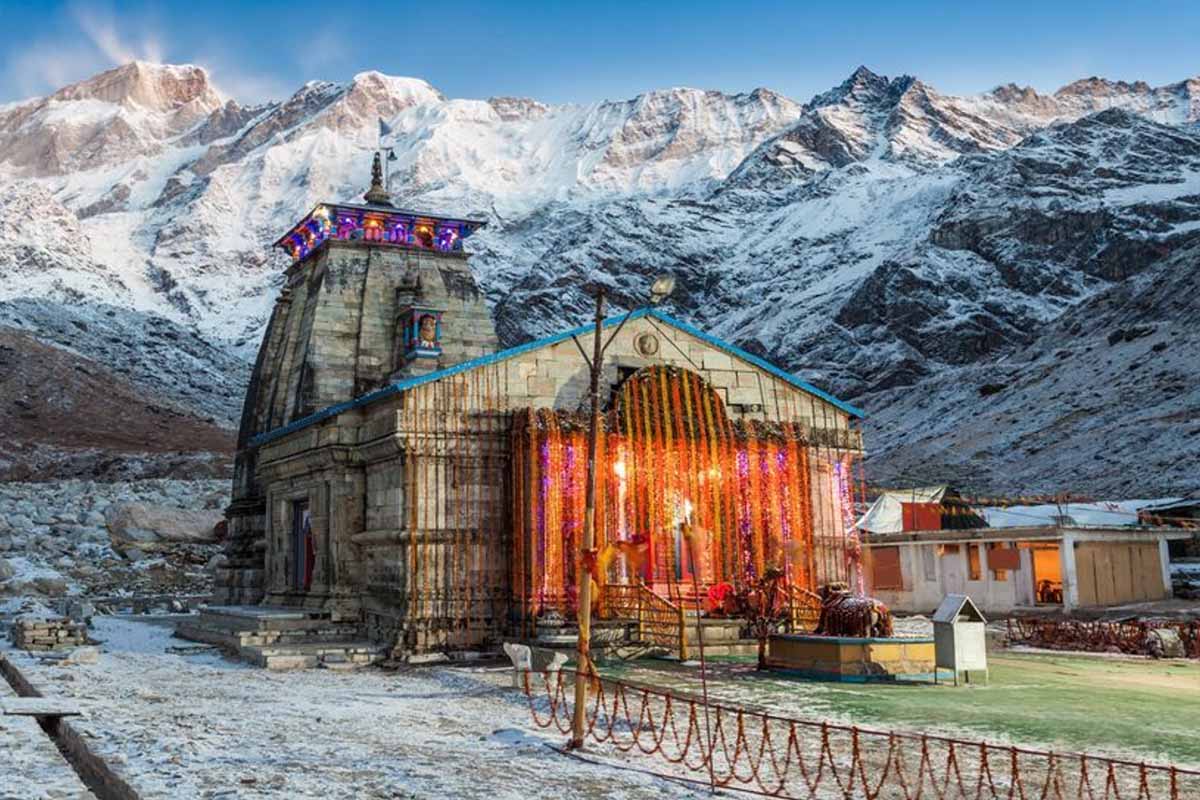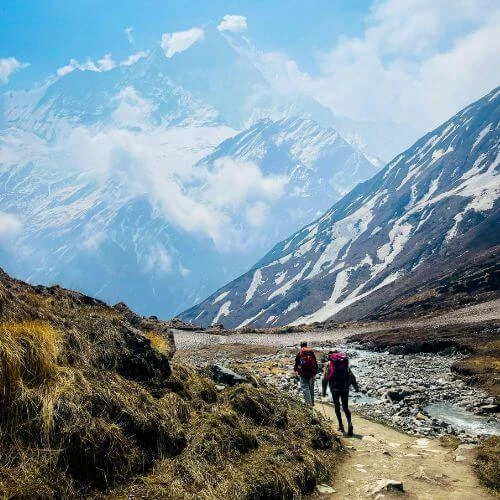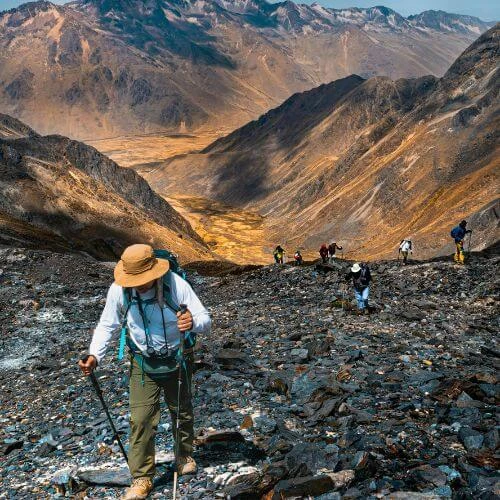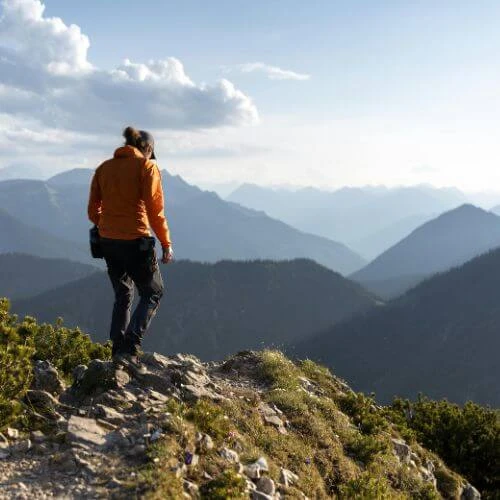Mount Kailash Kora, Tibet
The Kailash Mansarovar Yatra is one of the most sacred and demanding religious treks. It takes place in Tibet at Mount Kailash, a 22,028-foot-high mountain that is considered holy by Hindus, Buddhists, Jains, and followers of the Bon religion.
The Hindus consider Mount Kailash to be the residence of Lord Shiva and Parvati. The pilgrimage also includes a journey to Lake Mansarovar, a beautiful high-altitude lake at an elevation of 15,060 feet. The devotees believe that bathing in the crystal blue water cleanses their sins and brings prosperity.
The majority of the pilgrimage is the Parikrama or Kora, a 52-kilometer trek around Mount Kailash. All pilgrims walk this route for approximately three days though some take longer. The trek is very challenging due to its high altitude, rough road surface, and unpredictable weather conditions. Since Mount Kailash is in Tibet, visitors need to get special permits to travel there. Most pilgrims go with organized tours that take care of paperwork and transportation. There are two well-known routes to go to Kailash Mansarovar: one from Nepal and the other from China. The Nepal route is more popular among Indian pilgrims, while the China route is better road-wise but more expensive.

Quick Facts
- Location: Tibet, near the India-Nepal-China border.
- Main Attraction: Mount Kailash (22,028 ft) – Sacred in Hinduism, Buddhism, Jainism, and Bon religion.
- Lake Mansarovar: A holy high-altitude lake (15,060 ft) believed to cleanse sins.
- Trek Distance: 52 km Kora (Parikrama) around Mount Kailash.
- Duration: 3 days for the trek, 10-14 days for the full pilgrimage.
- Difficulty Level: Challenging – High altitude, rough terrain, and extreme weather.
- Best Time to Visit: May to September (favorable weather).
- Entry Requirements: Special permits are required (Tibet travel permits).
Ramayana Tour , Sri Lanka
Ramayana Tour of Sri Lanka is a Sacred pilgrimage tour that follows the route of the ancient Indian epic, Ramayana. The tour leads one to places where, according to the myth, Lord Rama traveled in search of his wife Sita when she was kidnapped by Ravana, the king of Lanka.
The tour begins normally in Chilaw, where there are ancient temples marking the place where Lord Rama first met the monkey king Sugriva. Pilgrims then visit Talaimannar, considered part of the mythological Ram Setu (Adam's Bridge), a series of limestone shoals that once existed as a chain linking India and Sri Lanka. Legend has it that Lord Rama's army of monkeys constructed the bridge in order to bridge the sea.
One of the tourist attractions of the trip is Ashok Vatika in Sita Eliya, where Sita was held captive in a beautiful garden. Today, the place has a temple of Sita, with peaceful gardens on either side that enhance the drama of the incident. Close by is the Hakgala Botanical Garden, believed to be Ravana’s pleasure garden, where he kept Sita. The tour also includes Ravana Caves near Ella, where Ravana supposedly hid Sita. The caves are said to be ancient engineering wonders. Divurumpola, where Sita was subjected to the fire test (Agni Pariksha) to prove her innocence to Lord Rama, is another significant place.

Quick Facts
- Location: Sri Lanka, following the path of the Ramayana epic.
- Main Attraction: Sacred sites related to Lord Rama and Sita, including Ashok Vatika and Ravana Caves.
- Key Sites: Chilaw, Talaimannar (Ram Setu), Ashok Vatika, Ravana Caves, Divurumpola.
- Trek Distance: Varies by route, with visits to multiple pilgrimage locations.
- Duration: 5-7 days to explore key sites.
- Difficulty Level: Easy to moderate
- Best Time to Visit: December to April (favorable weather).
- Entry Requirements: No special permits are required for most sites (some may require permission for restricted areas).
Gosaikunda Heli Tour , Nepal
Gosaikunda Heli Tour is a unique and breathtaking way of visiting one of Nepal's highest and most sacred high-altitude lakes. Gosaikunda Lake, 4,380 meters (14,370 feet) above sea level in Langtang National Park, is a pilgrimage site for Hindus and Buddhists and is linked to Lord Shiva and Guru Rinpoche.
The helicopter flight makes this holy pilgrimage accessible to those who cannot manage the challenging trek, such as elderly pilgrims or those with limited time. The journey begins in Kathmandu, where passengers board a helicopter. They then fly over the stunning Langtang mountain range, with spectacular views of snow-capped mountains, valleys, and forests.
Gosaikunda was created when Lord Shiva struck a lake with his trident after he had swallowed poison, according to Hindu mythology. The lake is frozen for six months in winter, and its crystal clear water is believed to possess medicinal qualities. The lake is visited by thousands of pilgrims for a holy dip on the full moon of August (Janai Purnima). The heli tour typically includes a short landing near the lake (20-30 minutes), which allows pilgrims to perform rituals, take pictures, and experience the peaceful surroundings. One can see stunning views of Langtang Lirung, Ganesh Himal, Dorje Lakpa, Manaslu, and Annapurna Himal on this tour.

Quick Facts
- Location: Langtang National Park, Nepal
- Main Attraction: Gosaikunda Lake, sacred to Hindus and Buddhists
- Elevation: 4,380 meters (14,370 feet)
- Flight Duration: 30-40 minutes from Kathmandu
- Best Time to Visit: September to April (favorable weather)
- Entry Requirements: Langtang National Park permit and a Trekkers Information Management System (TIMS) card
Muktinath Heli Tour - Nepal
The Muktinath Heli Tour is one of the most amazing and easiest pilgrimages in the world. Muktinath, located in the Mustang region of Nepal, is a religious site for Hindus and Buddhists, dedicated to Lord Vishnu. At an altitude of 3,710 meters (12,172 feet) above sea level, Muktinath is believed to be a source of spiritual cleansing and freedom (Mukti), where pilgrims come to purify their souls. The heli tour makes it easier for those who cannot take the longer journey to reach this sacred site in no time.
The helicopter tour starts in Pokhara, which is one of the most beautiful cities in Nepal, and takes tourists over the picturesque scenery of the Annapurna and Dhaulagiri mountains. Along the way, you will see breathtaking landscapes, including valleys, rivers, and the desert landscape of Mustang.
When you arrive at Muktinath, you can show respect to the temple, perform religious worship, and take a bath in the 108 holy water spouts surrounding the temple. In the Hindu faith, a dip in those cold waters purifies the soul and brings it closer to spiritual liberation. The temple also has a sacred eternal flame that burns naturally, symbolizing the divine presence.

Quick Facts
- Location: Mustang district, Nepal
- Main Attraction: Muktinath Temple, 108 holy water spouts, Eternal flame at the temple
- Elevation: 3,710 meters (12,172 feet)
- Key Sites: Flight Duration: 30-40 minutes from Pokhara
- Duration of Tour: Half day
- Best Time to Visit: March to November (clear weather)
- Entry Requirements: Trekkers Information Management System (TIMS) card and Annapurna Conservation Area Project (ACAP) Permit
Pathivara Heli Tour - Nepal
The Pathivara Heli Tour takes visitors to one of Eastern Nepal's most important temples, the Pathivara Devi Temple at an elevation of 3,794 meters (12,448 feet). The temple is dedicated to Goddess Pathivara, a powerful goddess in Hindu mythology.
The helicopter flight usually starts at Biratnagar or Kathmandu and offers spectacular views of the eastern Himalayas, including the world's third-highest mountain, Mount Kanchenjunga. The flight also glides over forests, fields, and tiny villages. Pathivara is a sacred destination for individuals seeking to pray for blessings. People believe that the goddess assists with marriage, children, and wealth wishes. Due to this reason, the temple receives thousands of pilgrims annually.
The temple is designed in the traditional Nepali style with wood and metalwork. The central temple contains the deity of Goddess Pathivara, with smaller shrines and peaceful spaces around it. The high-altitude location makes it a quiet place to pray, with clouds generally below the temple. The heli tour typically offers 1-2 hours at the temple for worship and absorbing the peaceful environment. In good weather, tourists can also identify stunning views of the Himalayan range, including Mount Kanchenjunga and Mount Makalu.

Quick Facts
- Location: Taplejung district, Nepal
- Main Attraction: Pathivara Devi Temple, a sacred pilgrimage site
- Elevation: 3,794 meters (12,447 feet)
- Key Sites: Pathivara Temple, panoramic views of Kanchenjunga and eastern Himalayas
- Flight Duration: 1-1.5 hours from Kathmandu
- Duration of Tour: Half-day
- Best Time to Visit: March to May, September to November (clear weather)
- Entry Requirements: No special permits are required, but local entry fees may apply
Char Dham - India
The Char Dham is a group of four sacred pilgrimage sites in India. It is the best pilgrimage walk in the world and is located in Uttarakhand. These sites are important to Hindus and are believed to help people achieve salvation (moksha). The four sites are:
1. Yamunotri: The first site, located at the source of the Yamuna River, is dedicated to Goddess Yamuna. It’s known for hot springs where pilgrims bathe for purification.
2. Gangotri: The second site, at the source of the Ganges River, is dedicated to Goddess Ganga. Pilgrims come to bathe in the river’s icy waters to cleanse their sins.
3. Kedarnath: The third site and a famous pilgrimage site around the world, dedicated to Lord Shiva, is located in the Himalayas. It is one of the 12 Jyotirlingas and requires a challenging trek to reach the temple.
4. Badrinath: The fourth site, dedicated to Lord Vishnu, is one of the most famous pilgrimage locations in India, attracting thousands of visitors each year.
Visiting all four sites is believed to purify the soul and bring spiritual liberation. Pilgrims visit these Hindu pilgrimage treks to seek blessings for health, prosperity, and peace, while also enjoying the peaceful surroundings of the Himalayan mountains.
 Quick Facts
Quick Facts
- Location: Uttarakhand, India
- Main Attraction: Four sacred Hindu pilgrimage sites – Yamunotri, Gangotri, Kedarnath, and Badrinath
- Elevation: Varies (Yamunotri – 3,293m, Gangotri – 3,415m, Kedarnath – 3,583m, Badrinath – 3,300m)
- Key Sites: Temples of the four dhams, River Yamuna & Ganges origins, Kedarnath Shiva Temple, Badrinath Vishnu Temple
- Duration of Tour: 10-14 days by road, shorter by helicopter
- Best Time to Visit: May to October (closed during winter due to heavy snowfall)
- Entry Requirements: No special permit is required, but biometric registration is mandatory for pilgrims
Inca Trail to Machhu Pichhu - Peru
The Inca Trail to Machu Picchu is one of the best pilgrimage hikes in the world in the heart of the ancient world of the Incas. The stone path, which was formerly part of an extensive 39,000-kilometer network of roads, was a sacred pilgrimage to Machu Picchu. Along the route are several ancient ruins with religious significance where the Incas would perform ceremonies.
The Incas believed walking along this route was a form of contact with their ancestors and gods. Every step was sacred, and the hike strengthened them physically and spiritually before they reached Machu Picchu, a holy city. The classical Inca Trail is a 4-day, 42-kilometer (26-mile) trek starting close to Cusco, through cloud forests, mountain passes, and old ruins like Wiñay Wayna and the Sun Gate (Inti Punku).
One of the world's leading pilgrimage hikes, the Machu Picchu and the trail are UNESCO World Heritage Sites and have preservation strictures in place, allowing only 500 individuals per day to ascend, with reservation well in advance being required. Similar to other pilgrim holy site pilgrimages, such as the Camino de Santiago pilgrimage, there's a cultural in addition to spiritual experience for this hike. Local residents still celebrate the blessing of Pachamama (Mother Nature) before ascending even today.

Quick Facts
- Location: Cusco region, Peru
- Main Attraction: Ancient Inca trail leading to the iconic Machu Picchu ruins
- Elevation: Highest point – Dead Woman’s Pass (4,215 meters / 13,828 feet)
- Key Sites: Sacred Valley, Sun Gate (Inti Punku), Wiñay Wayna, Machu Picchu
- Duration of Tour: 4 days / 3 nights (Classic Inca Trail)
- Best Time to Visit: May to September (dry season)
- Entry Requirements: Special Inca Trail permit required; must book in advance through a licensed tour operator
Tibet Cultural Tour and Lhasa Tour - Tibet
Tibet Cultural Tour and the Lhasa Tour are two of the most famous pilgrimage tours in the world. These tours give tourists a chance to witness Tibetan Buddhism, old monasteries, and sacred traditions. Tibet is also known as the "Roof of the World" because of its high mountain ranges. It is a place with powerful spiritual energy and deep religious beliefs. Many Buddhists and pilgrim travelers visit Tibet to explore its holy sites, and hence it is an important holy site tour destination. Lhasa, the capital of Tibet, is the country's spiritual and cultural center.
It contains some of the most important Buddhist sites on the planet. The most visited is the Potala Palace, a UNESCO World Heritage site, and the old winter palace of the Dalai Lama. The Red Hill Palace has magnificent views of the city and pilgrims climb its many stairs to see old rooms, chapels, and sacred artifacts. Another important place is the Jokhang Temple, Tibet's most sacred temple. Thousands of pilgrims visit it each year, some walking for weeks, bowing as an act of respect. The temple has a revered image of Jowo Rinpoche, a highly respected image of Buddha. Around the temple is Barkhor Street, where the believers walk in procession while chanting and rotating prayer wheels.

Quick Facts
- Location: Tibet Autonomous Region, China
- Main Attraction: Lhasa, Potala Palace, Jokhang Temple, Tibetan monasteries, and culture
- Elevation: Lhasa – 3,656 meters (11,995 feet)
- Key Sites: Potala Palace, Jokhang Temple, Barkhor Street, Sera Monastery, Norbulingka Palace
- Duration of Tour: 4-10 days, depending on itinerary
- Best Time to Visit: April to October (mild weather and clear skies)
- Entry Requirements: Tibet Travel Permit (issued through a registered tour operator) and a Chinese visa
Kumano Kodo - Japan
Kumano Kodo is a spiritual journey around the world, a deep spiritual journey in the history of Japan. This 1,000-year-old trail, in the Kii Peninsula, was walked by emperors, monks, and pilgrims. It is one of two pilgrimage trails recognized by UNESCO, the other being Spain's Camino de Santiago. The trail takes three sacred shrines, called the Kumano Sanzan, and leads tourists through forests, hills, and countryside villages.
The three grand shrines of Kumano hold special spiritual significance. The main shrine, Kumano Hongu Taisha, is in a forest and symbolizes spiritual renewal. Kumano Nachi Taisha is famous for being alongside Nachi Waterfall, Japan's highest waterfall, and is therefore a place of purification and natural beauty. Kumano Hayatama Taisha, on the seashore, symbolizes where nature meets the gods and houses over 800-year-old sacred trees.
Pilgrims travel through ancient cedar forests, mountain fog, and villages along the route. Smaller Oji shrines along the way function as rest stops and places to pray. Pilgrims also visit hot springs (onsen), which cleanse the body and soul before they visit the sacred grounds.

Quick Facts
- Location: Kii Peninsula, Wakayama Prefecture, Japan
- Main Attraction: Ancient pilgrimage routes to Kumano Sanzan (Three Grand Shrines)
- Elevation: Varies (highest point – 1,200 meters / 3,937 feet)
- Key Sites: Kumano Hongu Taisha, Kumano Nachi Taisha, Kumano Hayatama Taisha, Nachi Falls
- Duration of Tour: 5-7 days (for the full pilgrimage route)
- Best Time to Visit: March to November (mild weather)
- Entry Requirements: No special permits are required, but booking with a licensed guide is recommended for remote areas
Camino de Santiago - Spain
The Camino de Santiago, or Way of St. James, is a famous pilgrimage route in Spain that has been followed for over 1,000 years. Pilgrims walk the path to reach the Cathedral of Santiago de Compostela, where the remains of St. James the Apostle are said to be buried. St. James the Apostle was one of the twelve disciples of Jesus Christ and is an important figure in Christianity. He is believed to have traveled to Spain to spread the message of Christianity and became a martyr for his faith
The Camino de Santiago is famous because it is a spiritual journey that leads pilgrims to this holy site. It is one of the most important Christian pilgrimages, alongside others like the ones to Jerusalem or Rome. Pilgrims from around the world walk the Camino for various reasons, including religious devotion, personal reflection, and self-discovery. The route’s historic significance and connection to St. James make it an essential destination for Christians and a source of spiritual inspiration.

Quick Facts
- Location: Various routes across Spain (Main route: Camino Francés)
- Main Attraction: Pilgrimage route leading to the Cathedral of Santiago de Compostela
- Elevation: Varies (highest point – O Cebreiro, 1,300 meters / 4,265 feet)
- Key Sites: Cathedral of Santiago de Compostela, Cruz de Ferro, O Cebreiro, numerous churches and historical sites
- Duration of Tour: 30-40 days (full Camino Francés); shorter options available
- Best Time to Visit: April to October (spring to autumn)
- Entry Requirements: Pilgrim’s Passport is required for official recognition and to stay in hostels

.webp)



 based on 4 reviews
based on 4 reviews







 Quick Facts
Quick Facts 






